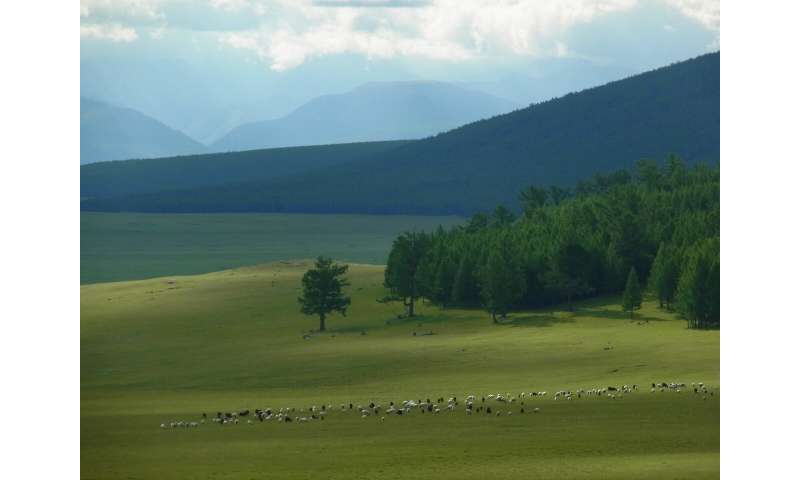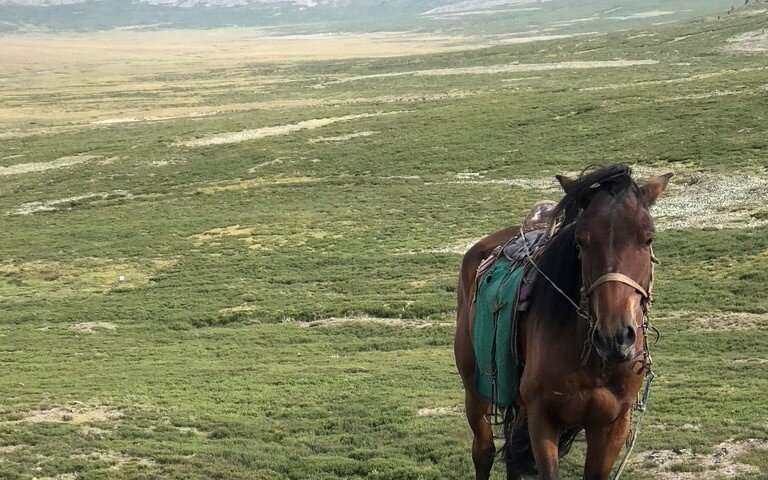
Cultivated land in northern Mongolia. Credit: Alicia Ventresca Miller
Researchers have examined stable isotopes from bone collagen and dental enamel to reconstruct the diets of ancient Mongolians. Findings challenge the popular notion of a completely nomadic prehistoric population, linking grain cultivation with the success of the Xiongnu Empire (c. 200 BCE-150 CE) and showing continual grain consumption during the Mongol Empire of the Khans (c. 1200-1400 CE).
The historic economies of Mongolia are among the least understood of any region in the world. The region's persistent, extreme winds whisk away signs of human activity and prevent the buildup of sediment that archaeologists rely on to preserve the past. Today, crop cultivation comprises only a small percent of Mongolia's food production, and many scholars have argued that Mongolia presents a unique example of dense human populations and hierarchical political systems forming without intensive farming or stockpiling grains.
The current study, led by Dr. Shevan Wilkin of the Max Planck Institute for the Science of Human History provides the first detailed glimpse into the diets and lives of ancient Mongolians, underscoring the importance of millets during the formation of the earliest empires on the steppe.
Isotopic analysis and the imperial importance of millets
Collaborating with archaeologists from the National University of Mongolia and the Institute of Archaeology in Ulaanbaatar, Dr. Wilkin and her colleagues from the MPI SHH sampled portions of teeth and rib bones from 137 previously excavated individuals. The skeletal fragments were analysed in the ancient isotope lab in Jena, Germany, where researchers extracted bone collagen and dental enamel to examine the ratios of stable nitrogen and carbon isotopes within. With these ratios in hand, scientists were able to reconstruct the diets of people who lived, ate, and died hundreds to thousands of years ago.
Researchers tracked the trends in diet through the millennia, creating a "dietscape" that clearly showed significant differences between the diets of Bronze Age peoples and those who lived during the Xiongnu and Mongol Empires. A typical Bronze Age Mongolian diet was based on milk and meat, and was likely supplemented with small amounts of naturally available plants. Later, during the Xiongnu Empire, human populations displayed a larger range of carbon values, showing that some people remained on the diet common in the Bronze Age, but that many others consumed a high amount of millet-based foods. Interestingly, those living near the imperial heartlands appear to have been consuming more millet-based foods than those further afield, which suggests imperial support for agricultural efforts in the more central political regions. The study also shows an increase in grain consumption and increasing dietary diversity through time, leading up to the well-known Mongolian Empire of the Khans.

Mongolian landscape with pastoral herd of sheep and goats. Credit: Alicia Ventresca Miller

Horses are still used by many for transport across Mongolia. Credit: Shevan Wilkin
Rethinking Mongolian prehistory
The new discoveries presented in this paper show that the development of the earliest empires in Mongolia, like in other parts of the world, was tied to a diverse economy that included the local or regional production of grain. Dr. Bryan K. Miller, a co-author who studies the historical and archaeological records of Inner Asian empires, remarks that "these regimes were like most empires, in that they directed intricate political networks and sought to amass a stable surplus—in this case a primarily pastoral one that was augmented by other resources like millet."
"In this regard," Dr. Miller adds, "this study brings us one step closer to understanding the cultural processes that led humanity into the modern world."
The view that everyone in Mongolian history was a nomadic herder has skewed discussions concerning social development in this part of the world. Dr. Wilkin notes that "setting aside our preconceived ideas of what prehistory looked like and examining the archaeological record with modern scientific approaches is forcing us to rewrite entire sections of humanity's past."
Dr. Spengler, the director of the archaeobotany labs at the MPI SHH, emphasizes the importance of this discovery, noting that "this study pulls the veil of myth and lore off of the real people who lived in Mongolia millennia ago and lets us peak into their lives."
The study is published in Scientific Reports.
More information:
Economic Diversification Supported the Growth of Mongolia's Nomadic Empires, Scientific Reports, DOI: 10.1038/s41598-020-60194-0
Citation:
How millet sustained Mongolia's empires (2020, March 3)
retrieved 3 March 2020
from https://phys.org/news/2020-03-millet-sustained-mongolia-empires.html
This document is subject to copyright. Apart from any fair dealing for the purpose of private study or research, no
part may be reproduced without the written permission. The content is provided for information purposes only.
#Biology | https://sciencespies.com/biology/how-millet-sustained-mongolias-empires/
No comments:
Post a Comment